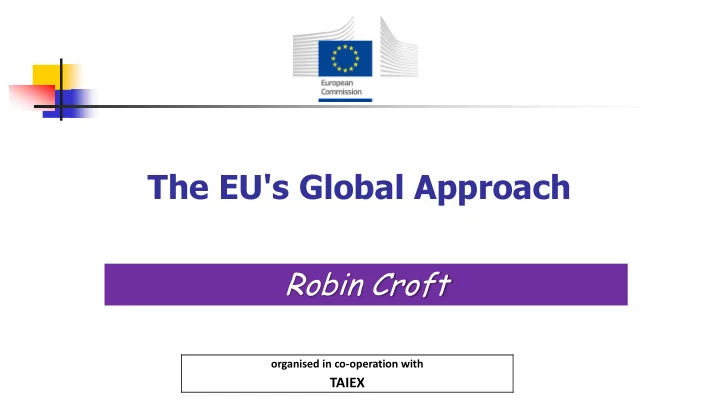

The EU's Global Approach Robin Croft organised in co-operation with TAIEX
Introduction A general overview of the Quality Framework in the EU internal market, including: EC Directives & Regulations Harmonised standards Accreditation and Notification Conformity Assessment Procedures 2
Interest in EU Conformity Assessment Compulsory for ALL new member states Requires harmonisation with EU Acquis Necessary for: Partnership & Co-operation Agreements Association Agreements Deep and Comprehensive Fair Trade Agreements Requires approximation of the EU Acquis Gives access to the Single Market 3
The Single Market EUROPEAN INTERNAL MARKET Free movement of persons Free Movement of Services No border control Liberalisation of financial services Harmonisation of legislation Harmonisation of surveillance of Free establishment and choice banks and insurers Opening of transport and of working place Stronger control of EU borders telecommunications markets Free Movement of Goods Free Movement of Capital No border control More free movement for money Harmonisation and mutual and capital Steps towards a common recognition of standards markets for financial services and legislation Liberalisation of the movement of Tax harmonisation bonds 4
Conformity Assessment – The context Product Safety rules cover not only rules made to prevent accident, but also those designed to protect health, the environment and the consumer more generally. In the WTO, Product Safety rules and regulations are covered by the Technical Barriers to Trade (TBT) Agreement. Therefore, it is an area where rules can have wide ranging consequences for trade and trade negotiatio ns 5
EU ACQUIS Approximation To replace a former “control system” with an EU compatible system requires: Approximation of EU Directives , implemented through the adoption of European Standards with enforcement through Market Surveillance. Alignment of technical regulations , standards and systems for conformity assessment with those of the EU and a Quality Infrastructure to implement EU new and global approach directives. 6
Essential Elements of the EU Approach Conformity EC Directives Harmonised Assessment Standards Essential requirements Procedures Presumption of conformity CE Marking International Accreditation Declaration of Co-operation Notification Conformity MARKET Quality Product SURVEILLANCE Assurance Liability 7
Horizontal and vertical regulations & directives General Product Safety Directive ( 2001/95/EC ) Directive liability defective products ( 85/374/EEC ) Accreditation and Market Surveillance (R - 765/2008) Framework for the marketing of products (D - 768/2008) Products lawfully marketed in another Member State (764/2008) Standardization (1025/2012) + Information procedure (98/34/EC) Horizontal Legislation Global Approach Optional (“ old ”) New Approach Approach Directives Directives Vertical Legislation Vertical Legislation
Regulated area Non regulated area Old Approach Directives New Approach Directives National laws Technical regulations Conformity Assessment ( DECISION No 768/2008/EC on a common REGULATION No 765/2008 setting out the framework for the marketing of products) requirements for accreditation Safety of products ( 2001/95/EC General product safety ) Liability for defective products ( 85/374/EEC )
The Old Approach Traditional approach to product legislation detailed regulations containing all the necessary technical and administrative requirements for each type of product. This reflected the existing national approach to product legislation. This approach is still employed for foodstuffs, biocides, motor vehicles, chemicals, cosmetics, detergents and pharmaceutical products. 10
Old Approach in practice 11
The New Approach Launched in 1985 through Council Decision 85/C 136/01 Built upon a combination of EU Directives or Regulations General safety objectives for a broad sector or family of products, or type of hazard Detailed harmonised standards developed by the European standards organisations, CEN, CENELEC and ETSI Published in the EC Official Journal and transposed without change into the national standards. 12
Principle of “essential requirements” Manufacturer is not actually obliged to meet the published European standards MUST meet the ‘ essential requirements ’ set in the relevant Directive or Regulation. But if the product conforms to harmonised standards , then there is a presumption of conformity that the product conforms with the essential requirements Choice is the prerogative of the manufacturer 13
EU Quality Framework for Product Safety PRINCIPLES: Internal QC Manufacturers and should importers are solely guarantee responsible for the safety safety of their Manufacturer products. Some products do need to be checked by a conformity assessment body – SAFE PRODUCTS Conformity notified body Market Assessment Body Surveillance BUT some specific Authority products – toys & Assists electrical products manufacturer Protects both DO NOT need any to design and 3 rd party product consumers & produce safe traders certification Consumers products 14
MARKET Design Production Sale, use, “in Technical and legal service”, end of life requirements 15 Economic Operators
Regulator / Conformity Manufacturers or Standards Government Assessment Importers body Horizontal Standards Directives (EN) PRODUCT Standards Product (EN) Directives Essential Standards requirements (EN) Market Supply Surveillance Placed on the market Chain Authorities In Use Consumers Manufactures/Importers 16
EU philosophy: Responsibilities Customs Producer Authorities Conformity Before Assessment *Customs + control Market Risk (if imported) Assessment “Ex Ante” After “Ex Post” Compliance Continuing Assessment Placing Conformity + on the Assessment Risk Assessment Market Producer Market Importer Surveillance Distributor Authorities
Recommend
More recommend